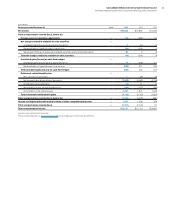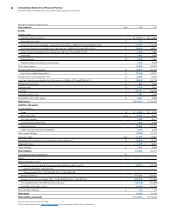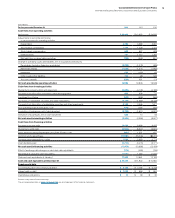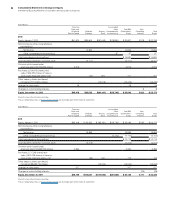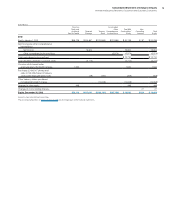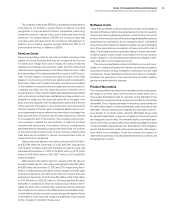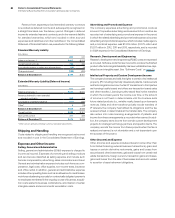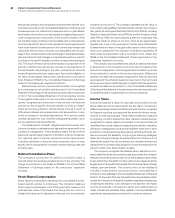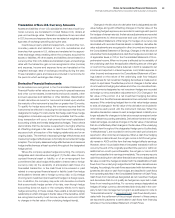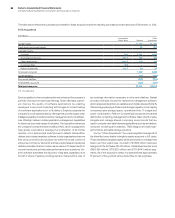IBM 2012 Annual Report Download - page 82
Download and view the complete annual report
Please find page 82 of the 2012 IBM annual report below. You can navigate through the pages in the report by either clicking on the pages listed below, or by using the keyword search tool below to find specific information within the annual report.Notes to Consolidated Financial Statements
International Business Machines Corporation and Subsidiary Companies
81
Business Combinations and
Intangible Assets Including Goodwill
The company accounts for business combinations using the acqui-
sition method and accordingly, the identifiable assets acquired, the
liabilities assumed, and any noncontrolling interest in the acquiree
are recorded at their acquisition date fair values. Goodwill represents
the excess of the purchase price over the fair value of net assets,
including the amount assigned to identifiable intangible assets. The
primary drivers that generate goodwill are the value of synergies
between the acquired entities and the company and the acquired
assembled workforce, neither of which qualifies as an identifiable
intangible asset. Goodwill recorded in an acquisition is assigned to
applicable reporting units based on expected revenues. Identifiable
intangible assets with finite lives are amortized over their useful lives.
Amortization of completed technology is recorded in Cost, and
amortization of all other intangible assets is recorded in SG&A
expense. Acquisition-related costs, including advisory, legal,
accounting, valuation and other costs, are expensed in the periods
in which the costs are incurred. The results of operations of acquired
businesses are included in the Consolidated Financial Statements
from the acquisition date.
Impairment
Long-lived assets, other than goodwill and indefinite-lived intangible
assets, are tested for impairment based on undiscounted cash flows
and, if impaired, written down to fair value based on either discounted
cash flows or appraised values. Goodwill and indefinite-lived intan-
gible assets are tested annually, in the fourth quarter, for impairment
and whenever changes in circumstances indicate an impairment may
exist. Goodwill is tested at the reporting unit level which is the operat-
ing segment, or a business, which is one level below that operating
segment (the “component” level) if discrete financial information is
prepared and regularly reviewed by management at the segment
level. Components are aggregated as a single reporting unit if they
have similar economic characteristics.
Depreciation and Amortization
Property, plant and equipment are carried at cost and depreciated
over their estimated useful lives using the straight-line method. The
estimated useful lives of certain depreciable assets are as follows:
buildings, 30 to 50 years; building equipment, 10 to 20 years; land
improvements, 20 years; plant, laboratory and office equipment, 2
to 20 years; and computer equipment, 1.5 to 5 years. Leasehold
improvements are amortized over the shorter of their estimated
useful lives or the related lease term, rarely exceeding 25 years.
Capitalized software costs incurred or acquired after techno-
logical feasibility has been established are amortized over periods
ranging up to 3 years. Capitalized costs for internal-use software
are amortized on a straight-line basis over periods up to 2 years.
Other intangible assets are amortized over periods between 1 and
7 years.
Environmental
The cost of internal environmental protection programs that are
preventative in nature are expensed as incurred. When a cleanup
program becomes likely, and it is probable that the company will
incur cleanup costs and those costs can be reasonably estimated,
the company accrues remediation costs for known environmental
liabilities. The company’s maximum exposure for all environmental
liabilities cannot be estimated and no amounts are recorded for
environmental liabilities that are not probable or estimable.
Asset Retirement Obligations
Asset retirement obligations (ARO) are legal obligations associated
with the retirement of long-lived assets. These liabilities are initially
recorded at fair value and the related asset retirement costs are
capitalized by increasing the carrying amount of the related assets
by the same amount as the liability. Asset retirement costs are sub-
sequently depreciated over the useful lives of the related assets.
Subsequent to initial recognition, the company records period-to-
period changes in the ARO liability resulting from the passage of
time in interest expense and revisions to either the timing or the
amount of the original expected cash flows to the related assets.
Defined Benefit Pension and
Nonpension Postretirement Benefit Plans
The funded status of the company’s defined benefit pension plans
and nonpension postretirement benefit plans (retirement-related
benefit plans) is recognized in the Consolidated Statement of Finan-
cial Position. The funded status is measured as the difference
between the fair value of plan assets and the benefit obligation at
December 31, the measurement date. For defined benefit pension
plans, the benefit obligation is the projected benefit obligation (PBO),
which represents the actuarial present value of benefits expected
to be paid upon retirement based on employee services already
rendered and estimated future compensation levels. For the non-
pension postretirement benefit plans, the benefit obligation is the
accumulated postretirement benefit obligation (APBO), which rep-
resents the actuarial present value of postretirement benefits
attributed to employee services already rendered. The fair value of
plan assets represents the current market value of cumulative com-
pany and participant contributions made to an irrevocable trust
fund, held for the sole benefit of participants, which are invested by
the trust fund. Overfunded plans, with the fair value of plan assets
exceeding the benefit obligation, are aggregated and recorded as
a prepaid pension asset equal to this excess. Underfunded plans,
with the benefit obligation exceeding the fair value of plan assets,
are aggregated and recorded as a retirement and nonpension post-
retirement benefit obligation equal to this excess.
The current portion of the retirement and nonpension postretire-
ment benefit obligations represents the actuarial present value of
benefits payable in the next 12 months exceeding the fair value of
plan assets, measured on a plan-by-plan basis. This obligation is
recorded in compensation and benefits in the Consolidated State-
ment of Financial Position.


